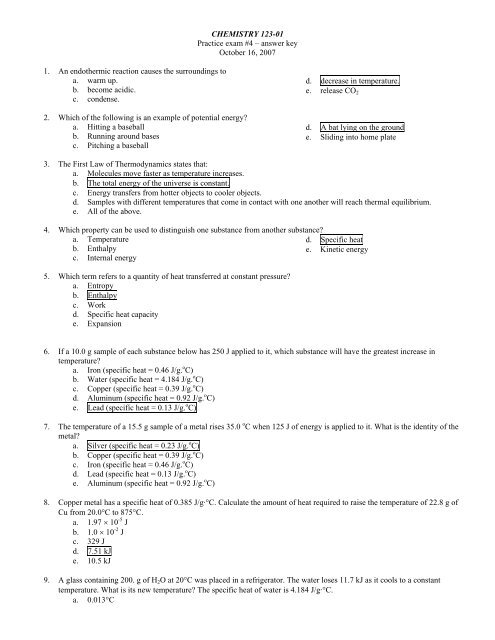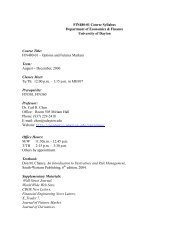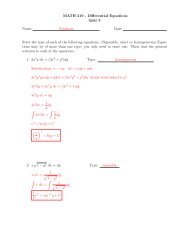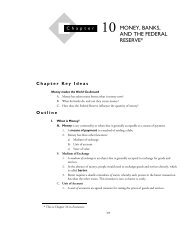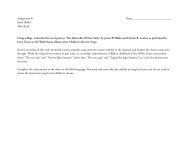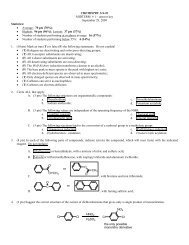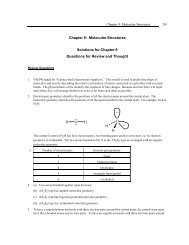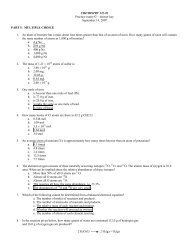Practice Exam 4 2007 Key - University of Dayton Academic Webserver
Practice Exam 4 2007 Key - University of Dayton Academic Webserver
Practice Exam 4 2007 Key - University of Dayton Academic Webserver
Create successful ePaper yourself
Turn your PDF publications into a flip-book with our unique Google optimized e-Paper software.
1. An endothermic reaction causes the surroundings to<br />
a. warm up.<br />
b. become acidic.<br />
c. condense.<br />
2. Which <strong>of</strong> the following is an example <strong>of</strong> potential energy?<br />
a. Hitting a baseball<br />
b. Running around bases<br />
c. Pitching a baseball<br />
CHEMISTRY 123-01<br />
<strong>Practice</strong> exam #4 – answer key<br />
October 16, <strong>2007</strong><br />
d. decrease in temperature.<br />
e. release CO2<br />
d. A bat lying on the ground<br />
e. Sliding into home plate<br />
3. The First Law <strong>of</strong> Thermodynamics states that:<br />
a. Molecules move faster as temperature increases.<br />
b. The total energy <strong>of</strong> the universe is constant.<br />
c. Energy transfers from hotter objects to cooler objects.<br />
d. Samples with different temperatures that come in contact with one another will reach thermal equilibrium.<br />
e. All <strong>of</strong> the above.<br />
4. Which property can be used to distinguish one substance from another substance?<br />
a. Temperature<br />
b. Enthalpy<br />
c. Internal energy<br />
5. Which term refers to a quantity <strong>of</strong> heat transferred at constant pressure?<br />
a. Entropy<br />
b. Enthalpy<br />
c. Work<br />
d. Specific heat capacity<br />
e. Expansion<br />
d. Specific heat<br />
e. Kinetic energy<br />
6. If a 10.0 g sample <strong>of</strong> each substance below has 250 J applied to it, which substance will have the greatest increase in<br />
temperature?<br />
a. Iron (specific heat = 0.46 J/g. o C)<br />
b. Water (specific heat = 4.184 J/g. o C)<br />
c. Copper (specific heat = 0.39 J/g. o C)<br />
d. Aluminum (specific heat = 0.92 J/g. o C)<br />
e. Lead (specific heat = 0.13 J/g. o C)<br />
7. The temperature <strong>of</strong> a 15.5 g sample <strong>of</strong> a metal rises 35.0 o C when 125 J <strong>of</strong> energy is applied to it. What is the identity <strong>of</strong> the<br />
metal?<br />
a. Silver (specific heat = 0.23 J/g. o C)<br />
b. Copper (specific heat = 0.39 J/g. o C)<br />
c. Iron (specific heat = 0.46 J/g. o C)<br />
d. Lead (specific heat = 0.13 J/g. o C)<br />
e. Aluminum (specific heat = 0.92 J/g. o C)<br />
8. Copper metal has a specific heat <strong>of</strong> 0.385 J/g·°C. Calculate the amount <strong>of</strong> heat required to raise the temperature <strong>of</strong> 22.8 g <strong>of</strong><br />
Cu from 20.0°C to 875°C.<br />
a. 1.97 × 10 -5 J<br />
b. 1.0 × 10 -2 J<br />
c. 329 J<br />
d. 7.51 kJ<br />
e. 10.5 kJ<br />
9. A glass containing 200. g <strong>of</strong> H2O at 20°C was placed in a refrigerator. The water loses 11.7 kJ as it cools to a constant<br />
temperature. What is its new temperature? The specific heat <strong>of</strong> water is 4.184 J/g·°C.<br />
a. 0.013°C
. 4°C<br />
c. 6°C<br />
d. 14°C<br />
e. 34°C<br />
10. Suppose a 50.0 g block <strong>of</strong> silver (specific heat = 0.2350 J/g·°C) at 100°C is placed in contact with a 50.0 g block <strong>of</strong> iron<br />
(specific heat = 0.4494 J/g·°C) at 0°C, and the two blocks are insulated from the rest <strong>of</strong> the universe. The final temperature <strong>of</strong><br />
the two blocks.<br />
a. will be higher than 50°C.<br />
b. will be lower than 50°C.<br />
c. will be exactly 50°C.<br />
d. is unrelated to the composition <strong>of</strong> the blocks.<br />
e. cannot be predicted.<br />
11. A 0.1326 g sample <strong>of</strong> magnesium was burned in an oxygen bomb calorimeter. The total heat capacity <strong>of</strong> the calorimeter plus<br />
water was 5,760 J/°C. If the temperature rise <strong>of</strong> the calorimeter with water was 0.570°C, calculate the enthalpy <strong>of</strong> combustion<br />
<strong>of</strong> magnesium.<br />
a. -3280 kJ/mol<br />
b. -24.8 kJ/mol<br />
c. 435 kJ/mol<br />
d. 106 kJ/mol<br />
e. -602 kJ/mol<br />
Mg(s) + 1/2O2(g) → MgO(s)<br />
12. To which one <strong>of</strong> these reactions occurring at 25°C does the symbol [H2SO4(l)] refer?<br />
a. 2H(g) + S(g) + 4O(g) → H2SO4(l)<br />
b. H2(g) + S(g) + 2O2(g) → H2SO4(l)<br />
c. H2SO4(l) → H2(g) + S(s) + 2O2(g)<br />
d. H2SO4(l) → 2H(g) + S(s) + 4O(g)<br />
e. H2(g) + S(s) + 2O2(g) → H2SO4(l)<br />
13. Octane (C8H18) undergoes combustion according to the following thermochemical equation:<br />
2C8H18(l) + 25O2(g) → 16CO2(g) + 18H2O(l) = -11,020 kJ/mol<br />
Given that [CO2(g)] = -393.5 kJ/mol and [H2O(l)] = -285.8 kJ/mol, calculate the standard enthalpy <strong>of</strong> formation <strong>of</strong><br />
octane.<br />
a. -210 kJ/mol<br />
b. -11,230 kJ/mol<br />
c. 22,040 kJ/mol<br />
d. -420 kJ/mol<br />
e. 420 kJ/mol<br />
14. Given 2Al(s) + (3/2)O2(g) → Al2O3(s), = -1,670 kJ/mol for Al2O3 (s).<br />
a. 3,340 kJ/mol<br />
b. 1,670 kJ/mol<br />
c. -3,340 kJ/mol<br />
d. -1,670 kJ/mol<br />
e. -835 kJ/mol<br />
Determine ΔH° for the reaction 2Al2O3(s) → 4Al(s) + 3O2(g)<br />
15. Given the thermochemical equation 2SO2 + O2 → 2SO3, = -198 kJ/mol, what is the standard enthalpy change for the<br />
decomposition <strong>of</strong> one mole <strong>of</strong> SO3?<br />
a. 198 kJ/mol<br />
b. -99 kJ/mol<br />
c. 99 kJ/mol<br />
d. 396 kJ/mol
e. -198 kJ/mol<br />
16. For the reaction C(graphite) + O2(g) → CO2(g), ΔH° = -393 kJ/mol. How many grams <strong>of</strong> C(graphite) must be burned to<br />
release 275 kJ <strong>of</strong> heat?<br />
a. 22.3 g<br />
b. 0.70 g<br />
c. 12.0 g<br />
d. 17.1 g<br />
e. 8.40 g<br />
17. Find the heat absorbed from the surroundings when 15 g <strong>of</strong> O2 reacts according to the equation O + O2 → O3, = 103<br />
kJ/mol.<br />
a. 4.6 × 10 -3 kJ<br />
b. 48 kJ<br />
c. 96 kJ<br />
d. 32 kJ<br />
e. 110 kJ<br />
18. At 25°C, the standard enthalpy <strong>of</strong> formation <strong>of</strong> KCl(s) is -435.87 kJ/mol. When one mole <strong>of</strong> KCl(s) is formed by reacting<br />
potassium vapor and chlorine gas at 25°C, the standard enthalpy <strong>of</strong> reaction is -525.86 kJ/mol. Find ΔH° for the sublimation<br />
<strong>of</strong> potassium, K(s) → K(g), at 25°C.<br />
a. -345.88 kJ/mol<br />
b. 45.00 kJ/mol<br />
c. 345.88 kJ/mol<br />
d. 89.99 kJ/mol<br />
e. -525.86 kJ/mol<br />
19. 10.1 g CaO is dropped into a styr<strong>of</strong>oam c<strong>of</strong>fee cup containing 157 g H2O at 18.0°C. If the following reaction occurs, then<br />
what temperature will the water reach, assuming that the cup is a perfect insulator and that the cup absorbs only a negligible<br />
amount <strong>of</strong> heat? [specific heat <strong>of</strong> water = 4.18 J/g·°C]<br />
a. 18.02°C<br />
b. 35.8°C<br />
c. 311°C<br />
d. 42.2°C<br />
e. 117°C<br />
CaO(s) + H2O(l) → Ca(OH)2(s) = -64.8 kJ/mol<br />
20. A gas is compressed in a cylinder from a volume <strong>of</strong> 20 L to 2.0 L by a constant pressure <strong>of</strong> 10.0 atm. Calculate the amount <strong>of</strong><br />
work done on the system.<br />
a. 1.01 × 10 4 J<br />
b. -180 J<br />
c. 1.81 ×10 4 J<br />
d. -1.81 × 10 4 J<br />
e. 180 J<br />
21. Which <strong>of</strong> the following processes always results in an increase in the energy <strong>of</strong> a system?<br />
a. The system loses heat and does work on the surroundings.<br />
b. The system gains heat and does work on the surroundings.<br />
c. The system loses heat and has work done on it by the surroundings.<br />
d. The system gains heat and has work done on it by the surroundings.<br />
e. None <strong>of</strong> these is always true.<br />
22. For which <strong>of</strong> these reactions will the difference between ΔH° and ΔE° be the smallest?<br />
a. N2(g) + 3H2(g) → 2NH3(g)<br />
b. 4PH3(g) → P4(g) + 6H2(g)<br />
c. H2(g) + Cl2(g) → 2HCl(g)<br />
d. CO2(g) + 2H2O(l) → CH4(g) + 2O2(g)<br />
e. P4(s) + 10Cl2(g) → 4PCl5(s)
PART II: CONCEPTS<br />
23. For each <strong>of</strong> the following, determine the value <strong>of</strong> ΔH2 in terms <strong>of</strong> ΔH1.<br />
a.<br />
A + B 2C ΔH 1<br />
2C A + B ΔH 2 = ?<br />
Answer: The second equation is obtained by reversing the first one. Therefore ΔH2 = - ΔH1<br />
b.<br />
A B + 2C ΔH 1<br />
1/2 B + C 1/2 A ΔH 2 = ?<br />
Answer: The second equation is obtained by reversing the first one and dividing it by 2. Therefore ΔH2 = - ½ ΔH1<br />
PART III: HESS’S LAW<br />
24. Calculate ΔH for the following reaction:<br />
Use the following reactions:<br />
Fe2O3 (s) + 3 CO (g) 2 Fe (s) + 3 CO2 (g)<br />
1) 2 Fe (s) + 3/2 O2 (g) Fe2O3 (s) ΔH = - 824.2 kJ<br />
2) CO (g) + ½ O2 (g) CO2 (g) ΔH = -282.7 kJ<br />
Answer: We need to reverse equation (1) since Fe2O3 (s) is on the reactant side in the equation in question. Equation (2)<br />
needs to be multiplied by 3 since the studied equation involves 3 moles <strong>of</strong> CO (g). As a result:<br />
1) Fe2O3 (s) 2 Fe (s) + 3/2 O2 (g) ΔH = + 824.2 kJ<br />
2) 3 CO (g) + 3/2 O2 (g) 3 CO2 (g) ΔH = -848.1 kJ<br />
Add equations (1) and (2):<br />
Fe2O3 (s) + 3 CO (g) + 3/2 O2 (g) 2 Fe (s) + 3/2 O2 (g) + 3 CO2 (g)<br />
Fe2O3 (s) + 3 CO (g) 2 Fe (s) + 3 CO2 (g)<br />
ΔH = + 824.2 kJ + (- 848.1 kJ) = - 23.9 kJ<br />
PART IV: STANDARD MOLAR ENTHALPIES OF FORMATION<br />
25. Write an equation for the formation <strong>of</strong> each <strong>of</strong> the following compounds from their constituent elements, in their standard<br />
states.<br />
a. NO2 (g)<br />
½ N2 (g) + O2 (g) NO2 (g)<br />
b. C2H4 (g)<br />
2 C (graphite) + 2 H2 (g) C2H4 (g)<br />
c. MgCO3 (s)<br />
Mg (s) + C (graphite) + 3/2 O2 (g) MgCO3 (s)
d. CH3OH (l)<br />
C (graphite) + 2 H2 (g) + ½ O2 (g) CH3OH (l)<br />
26. Use data on ΔHf o (Table 6.4 and Appendix 2) to calculate ΔH for each <strong>of</strong> the following reactions.<br />
a. 2 H2S (g) + 3 O2 (g) 2 H2O (l) + 2 SO2 (g)<br />
Answer: We know that, in general, ΔH for any reaction can be determined if we know the ΔHf o values <strong>of</strong> all reactants and<br />
products, using the equation:<br />
ΔH = Σ n x ΔHf o (products) – Σ m x ΔHf o (reactants)<br />
From Table 6.4: ΔHf o (H2S(g)) = - 20.15 kJ/mol<br />
ΔHf o (H2O(l)) = - 285.8 kJ/mol<br />
ΔHf o (SO2(g)) = - 296.1 kJ/mol<br />
We also know that for elements, in their standard states, ΔHf o = 0 kJ/mol. Therefore ΔHf o (O2 (g)) = 0 kJ/mol<br />
Using the above equation:<br />
ΔH = 2 x (- 285.8) + 2 x (- 296.1) – 2 x (-20.15) = - 1123.5 kJ<br />
ΔH = - 1123.5 kJ<br />
b. N2O4 (g) + 4 H2 (g) N2 (g) + 4 H2O (g)<br />
Answer: We use the same general equation:<br />
ΔH = Σ n x ΔHf o (products) – Σ m x ΔHf o (reactants)<br />
From Table 6.4: ΔHf o (N2O4(g)) = + 9.66 kJ/mol<br />
ΔHf o (H2O(g)) = - 241.8 kJ/mol<br />
For elements, in their standard states, ΔHf o = 0 kJ/mol. Therefore ΔHf o (H2 (g)) = 0 kJ/mol<br />
ΔHf o (N2 (g)) = 0 kJ/mol<br />
Using the above equation:<br />
ΔH = 4 x (- 241.8) – 1 x 9.66 = - 957.5 kJ<br />
ΔH = - 957.5 kJ


